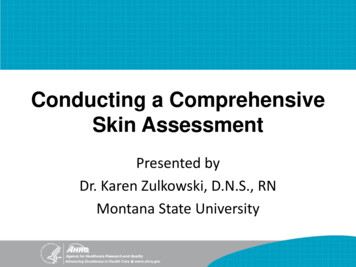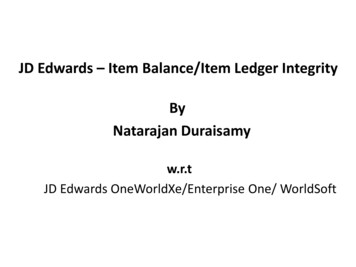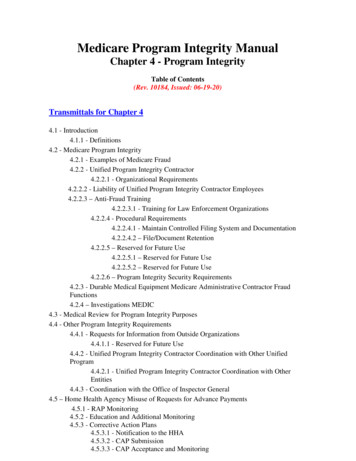![[ Toolkit For ] Skin Integrity Assessment](/img/22/skin-integrity-toolkit.jpg)
Transcription
[ Toolkit For ]Skin Integrity AssessmentRHSCIR 2.0A clinical guideline for basic pressure ulcer assessmentsfor individuals with spinal cord injury.February 2016 Version 3.0
TOOLKIT FOR SKIN INTEGRITY ASSESSMENTThis toolkit is supported by the Rick Hansen Instituteand was created by the following collaborators:Dalton Wolfe, PhDResearch ScientistParkwood HospitalChester Ho, MD, FRCPCAssociate Professor and HeadDivision of Physical Medicine & RehabilitationDepartment of Clinical Neurosciences, University of CalgaryFoothills HospitalJohn Cobb, BScOTOccupational Therapist IIVancouver General Hospital Acute Spine ProgramAcknowledgementsPamela Houghton, BScPT, PhDUniversity of Western OntarioKaren E. Campbell, APN, MScN, PHD(c)London Health Sciences Centre-University HospitalKristen Walden, BScPTNational Clinical LiaisonRick Hansen InstituteFor questions or comments on this guideline, please contactclinical@rickhanseninstitute.org.
01BACKGROUNDAbout RHSCIRThe RICK HANSEN SPINAL CORD INJURY REGISTRY (RHSCIR) is a pan-Canadian prospectiveobservational registry located at 31 major Canadian acute care and rehabilitation hospitals.Across Canada, RHSCIR is collecting comprehensive SCI data for the purpose of improving SCIcare and clinical outcomes. Using standardized research protocols and data collection forms,RHSCIR tracks the experiences and outcomes of people with traumatic SCI during their journeyfrom injury, through acute care and rehabilitation to community reintegration. Details aboutparticipants' spinal cord injuries including extent of injury and level of paralysis, recovery, andsuccess of various treatments are among the data recorded.The data collected in RHSCIR contains powerful information that will help track the effectivenessof specific treatments, practices or programs for improving functional outcomes and quality oflife after SCI. RHSCIR promotes, encourages and supports the pursuit of excellence in all areasof SCI health care management.This network of 31 hospitals has adopted a new goal of standardizing the basic assessment ofpressure ulcers (including pressure ulcer incidence and stage). A recent environmental scanand surveys collected by the Rick Hansen Institute (RHI) show that many hospitals currentlyuse a pressure ulcer assessment tool (1). This new pressure ulcer assessment guideline isnot meant to replace current clinical practice, but represents a standardized way to supporttracking and reporting of this important information. Collection of standardised data elementsacross the RHSCIR network will inform stakeholdersabout local hospital or program level trends,and allow comparison of your hospital data withnational trends, as well as capturing data thatcan be used to answer valuable clinicaland research questions nationally.To learn more about ion 3.0 February 2016 5BACKGROUNDRHSCIR facilities are located in 15 cities across Canada.
02WHY IS THIS INFORMATIONIMPORTANT?Variations in the quality of care for people with spinal cord injury (SCI) may increase the incidence ofcostly ongoing secondary complications such as pressure ulcers. Individuals with SCI have a life-longrisk of developing pressure ulcers with 95% of them developing at least one sometime during theirlifetime (1). Currently, pressure ulcers cost the Canadian health care system somewhere between 173 and 355.4 million annually (2,3), and have a negative impact on quality of life (4). Standardizedcollection of pressure ulcer incidence and severity data across Canada can help to track and compareyour facility’s rates of pressure ulcers.Information regarding the incidence and severity of pressure ulcers in the SCI population may be usedto identify trends which subsequently support program planning and resource allocation. Additionally,such information can serve as a basis for patient education as part of facilitating self-management anddirecting care.WHY IS THIS INFORMATION IMPORTANT?The data you collect (as outlined in this toolkit) will be added to RHSCIR. The RHSCIR project willprovide you and your program data entry services, data analysis services and standardized hospitallevel data reports with national-benchmarks available free of charge. The data you collect will assist inproviding validated and supported evidence-based practice with the potential to improve efficiencies inthe health care system and ultimately improve outcomes for individuals living with spinal cord injury.Read “What Happens Once I Collect the Data?” on page 6 to learn more about what happens with thedata you will collect.Benefits to Clinicians and PatientsBeing informed is a crucial part of an injured person’s recovery process. This toolkit provides step-bystep details on how to conduct pressure ulcer staging according to NPUAP guidelines (5). The NationalPressure Ulcer Advisory Panel (NPUAP) is the authoritative voice for improved patient outcomes inpressure ulcer prevention and treatment gained through public policy, education and research. Thisassessment and staging information can be used as the basis for patient education, which is part offacilitating skills in self-management and directing care.Collection and reporting of this data can benefit clinicians and patients by:Supporting patient education about pressure ulcer prevention and clarifying the patient’s roles andresponsibilities.Determining the incidence and severity of pressure ulcers along the care continuum. In turn, thiscan assist with the further development of pressure ulcer prevention protocols and determine wherethey are most needed.Allowing comparison of data across the country, which helps identify national trends regardingpressure ulcers in acute and rehab facilities. This comparison can also inform future goals to improvecare in these areas both nationally and locally.Toolkit for Skin Integrity Assessment 6
Assisting with directing specific treatment plans, patient education, and ensuring consistentcommunication and documentation between care providers.Ensuring less severe pressure ulcers are documented and monitored at admission potentiallylimiting progression to more severe stages.Tracking all pressure ulcers throughout the patient’s admission to determine if an identified pressureulcer has improved, resolved or is still present upon discharge which is a factor in monitoring theimpact of prevention and treatment plans, as well as in transitional care planning.Providing important data regarding whether a wound required surgical treatment, which can informongoing seating, positioning and mobilization care planning as well as providing information aboutpost-surgical recurrence rates.Enabling patients to provide ongoing self-report of pressure ulcers after they have been dischargedback to the community (through the RHSCIR Community Follow-up Questionnaire).With 15% of traumatic SCI patients developing at least one pressure ulcer at some point duringtheir acute care admission (6), effective guidelines are critical to improve patient outcomes, reducecosts and decrease hospital length of stay. Pressure ulcers are also a risk factor for other seriouscomplications such as osteomyelitis, septicemia, and psychological disorders as well as acting as abarrier to patients’ full participation in rehabilitation (7). Additionally, pressure ulcer risk assessmentand the implementation of pressure ulcer prevention strategies is a Required Organizational Practice(ROP) outlined by the Accreditation Canada Spinal Cord Injury Acute (8) and Rehabilitation ServicesStandards (9). These documents also promote the education of staff with regard to the prevention andtreatment of pressure ulcers.Collection and reporting of this data can benefit your program by:Tracking the incidence of pressure ulcers along the continuum of care, hence: Facilitating larger system planning (e.g. feedback to EHS transport systems) to coordinate andimprove service delivery between different points of care. Facilitating interventions targeted at the appropriate point of care (e.g. acute, rehabilitation orcommunity).Analysing staffing levels – determining what type of staff (e.g. RN, LPN, WOCN, OT, PT, research,etc.) are involved/required and determining equipment and supply requirements.Creating continuity between health care providers.Version 3.0 February 2016 7WHY IS THIS INFORMATION IMPORTANT?Benefits to the Program
Providing comparators to national data and a system of tracking to support requirements forAccreditation Canada SCI acute and rehabilitation standards and Required Organizational Practices.Reporting metrics to hospital administrators to allow correlation of program expenditures (e.g.equipment, regular and overtime staffing requirements, etc.) with pressure ulcer status as well aspatient demographics (e.g. age, neurology, etc.).WHY IS THIS INFORMATION IMPORTANT?What Happens Once I Collect the Data?Providing invaluable data to RHSCIR: Once you collect the data, your hospital’s RHSCIR coordinatorwill abstract the information from the medical record and input the data into the RHSCIR database(including additional pressure ulcer data collected in the community through self-report; see"RHSCIR - Additional Pressure Ulcer Data" on page 21), along with other clinical, demographic,sociodemographic, participant flow, and outcomes information. RHSCIR has developed a number ofpractices to ensure patient confidentiality is maintained and strict privacy policies and proceduresare followed.Providing a baseline for management of SCI across Canada: The de-identified data from yourhospital (including additional pressure ulcer data collected via self-report in the community) willbe reported to you on a quarterly basis, providing information on your hospital’s SCI pressure ulcerincidence and frequency, average length of stay (categorized by presence or absence of pressureulcer), and other information.To access your site’s data reports, visit Supporting Clinical Initiatives in SCI (SCI2) resource siteat http://sci2.rickhanseninstitute.org. Please see your local RHSCIR coordinator, or designatedrepresentative, to receive this log in information.You can also access the SCI2 site by visiting www.rickhanseninstitute.org.Toolkit for Skin Integrity Assessment 8
03RESOURCE REQUIREMENTSTo complete data collection as outlined in this toolkit, the followingresources are required:TimeEstimated time required for good clinical practice:No wounds - 5-10 minutes1-3 wounds - 10-20 minutes4 wounds - 20-30 minutesEquipmentPressure Ulcers Clinical Data Collection Form or your local hospital version with these questions integratedPaper, single-use (disposable) measuring tapeTwo sterile cotton swabs per woundVersion 3.0 February 2016 9RESOURCE REQUIREMENTSNOTE: This form is provided for convenience and meets the minimum requirements for RHSCIR datacollection. Please integrate this information into your local hospital pressure ulcer assessment tool. Ifyour facility does not have a data collection tool, please add any additional hospital specific informationto this form to meet your facility's practice requirements. If you would like assistance to combine yourexisting local hospital information and this form, please contact us at clinical@rickhanseninstitute.org.
04FORMSPressure Ulcers Clinical Data Collection FormA version of this form you can insert into your chart is available at http://sci2.rickhanseninstitute.org.CI-Pressure Ulcers-MULTRHSCIR ID #Reference Table / Legend (Please use reference tables below to complete the Pressure Ulcer Tracking Table)LocationLocation CodeRightMidlineOcciputABEarLeftNPUAP Pressure Ulcer Stages: (Staging and illustrations can be found l-resources/)CSDTIDEScapulaFG(Suspected DeepTissue Injury):ElbowHIRibsJKSpinous processLIliac crestOSacralQIschial ootGGHHIIIIPartial thickness loss of dermis presenting as a shallow open ulcer with a red pink woundbed, without slough. May also present as an intact or open/ruptured serum-filled blister.IIIFull thickness tissue loss. Subcutaneous fat may be visible but bone, tendon or muscle arenot exposed. Slough may be present but does not obscure the depth of tissue loss. Mayinclude undermining and tunneling.IVFull thickness tissue loss with exposed bone, tendon or muscle. Slough or eschar may bepresent on some parts of the wound bed. Often include undermining and tunneling.U (Unstageable)Full thickness tissue loss in which the base of the ulcer is covered by slough (yellow, tan,gray, green or brown) and/or eschar (tan, brown, or black) in the wound bed.ZAAHeelOther Location:Intact skin with non-blanchable redness of a localized area usually over a bonyprominence. Darkly pigmented skin may not have visible blanching; its colour may differfrom the surrounding area.UVGenitalsINPRJJPurple or maroon localized area of discolored intact skin or blood-filled blister due todamage of underlying soft tissue from pressure/and or shear. The area may be precededby tissue that is painful, firm, mushy, boggy, warmer or cooler as compared to adjacenttissue.KKNote: Please do not use reverse staging to document a healing pressure ulcer. A Stage IV pressure ulcer cannot become a Stage III, Stage II,and/or subsequently Stage I. When a Stage IV ulcer has healed it should be classified as a healed Stage IV pressure ulcer not a Stage 0 pressure ulcer.Reverse staging does not accurately characterize what is physiologically occurring in the ulcer.Qualifiers at discharge:Resolved: Skin is intact and no longer red, purple, indurated, painful, firm, mushy, boggy, warmer or cooler as compared to adjacent tissue. Refers toSDTI and stage I, where the skin was never open (therefore “closed” doesn’t work here).Closed: Ulcer is covered with epithelium (even a very thin layer) with no drainage. Refers to Stages II, III, IV and U.Healing: Decreasing in size, depth, amount of necrotic tissue or exudates, or increasing granulation tissue, etc. (see above). Refers to Stages II, III,IV and U.Data Collection DetailsCollected by:(please print name)FORMSVersion: 30Sep2015InitialHere:Date AbstractionCompleted:YYYY-MM-DDPage 3 of 3Toolkit for Skin Integrity Assessment 10
PRESSURE ULCERSMultiple Data Collection PointsCHART ABSTRACTIONCI-Pressure Ulcers-MULTRHSCIR ID #Pressure Ulcer Assessment Data Collection Point(check ONE only): Acute care (or Emergency and Acute care) providedRehab care providedInformation unavailable, unable to complete. Specify Reason:1.Any pressure ulcers during stay at facility? (please include any ulcers present on admission to the facility) Yes No (skip to Data Collection Details on page 3)Definitions related to pressure ulcer form: Please see page 3.Pressure Ulcer Assessment2. 4.Was a skin integrity risk assessment completed at admission?Yes SCIPUS (Score: )No Yes Other (specify): No5.Any pressure ulcers following admission to the facility (i.e. duringstay)? Yes NoComplete SectionsAandBadmission for each ulcer and Section This is a proxy for general nutritional status.Braden (Score: )Any pressure ulcers at admission assessment? (please include any ulcers presentYesof table below atC/ /YYYY-MM-Level: (g/L)AComplete SectionsBCat dischargeat discharge.NoAssessment Date:Was a pre-albumin level tested? on admission to the facility) 3.Assessment Date:DD/ /YYYYClinician Name/Signature:-MM-DDClinician Name/Signature:Page 1 of 3Version: 30Sep2015CI-Pressure Ulcers-MULTRHSCIR ID #6.Pressure Ulcer Tracking Table (See Definitions and Reference Tables on page 3)Pressure Ulcer IdentifierAStage at Admissionto Facility:Onset:Location (enterONE location codefrom table below): Admission Assessment(within 7 days after admission)Prior toAdmissionDuring stay SDTII IIIIIIVDischarge Assessment(within 7 days prior to discharge from facility)BQualifier at Admission If StageII, III, or IV:Stage at D/Cfrom Facility: SDTII IIIIIIV U UnknownDate of Appearance:/ /YYYY/ MM/DD UnknownPressure Ulcer IdentifierA UN/A (No ulcerat admission) UnknownPrior toAdmissionDuring stay NoUnknown SDTII IIIIIIVHealing? Yes No UnknownYYYY/ MM/DD UnknownPressure Ulcer IdentifierAOnset:Location (enterONE location codefrom table below): Prior toAdmissionDuring stay UN/A (No ulcerat admission) UnknownBQualifier at Admission If StageII, III, or IV:Closed? Yes NoUnknownStage at D/Cfrom Facility: SDTIIHealing? Yes No Unknown IIIIIIV U UnknownYYYY/ MM/DD UnknownBQualifier at Admission If StageII, III, or IV:Stage at D/Cfrom Facility:SDTII SDTII IIIIIIV IIIIIIV U UnknownUN/A (No ulcerat admission) Unknown Closed? Yes NoUnknown Healing? Yes No Unknown Biophysical (ultrasound,Estim, etc.)Pressure redistribution(sleeping and seatingsurface changes)Dressings (including VACdressing, occlusive, etc.)Minor/bedsidedebridementNo treatmentUnknownOther (specify):Has the ulcer been surgicallytreated?(Includes major surgical methodssuch as direct closure, skingrafting, rotation flaps ordebridement of ulcer surface; donot include minor debridement [i.e.bedside debridement byRN/OT/PT].) YesNoUnknownIf yes, date surgically treated:/ /Qualifier at Discharge if Stage SDTI,I, II, III, or IV:What type of non-surgicaltreatment was used?Resolved? Yes No Unknown Closed? Yes NoUnknown Healing? Yes No Unknown Biophysical (ultrasound,Estim, etc.)Pressure redistribution(sleeping and seatingsurface changes)Dressings (including VACdressing, occlusive, etc.)Minor/bedsidedebridementNo treatmentUnknownOther (specify):Has the ulcer been surgicallytreated?(Includes major surgical methodssuch as direct closure, skingrafting, rotation flaps ordebridement of ulcer surface; donot include minor debridement [i.e.bedside debridement byRN/OT/PT].) YesNoUnknownIf yes, date surgically treated:/ /Closed? Yes NoUnknownHealing? Yes No UnknownWhat type of non-surgicaltreatment was used?Resolved? Yes No Unknown Closed? Yes NoUnknown Healing? Yes No Unknown /MM /DDCQualifier at Discharge if Stage SDTI,I, II, III, or IV: /MM /DDCBiophysical (ultrasound,Estim, etc.)Pressure redistribution(sleeping and seatingsurface changes)Dressings (including VACdressing, occlusive, etc.)Minor/bedsidedebridementNo treatmentUnknownOther (specify):Has the ulcer been surgicallytreated?(Includes major surgical methodssuch as direct closure, skingrafting, rotation flaps ordebridement of ulcer surface; donot include minor debridement [i.e.bedside debridement byRN/OT/PT].) YesNoUnknownIf yes, date surgically treated:/ /YYYY/MM /DDIf the participant has more than 3 pressure ulcers, please complete an additional CI – Pressure Ulcers-MULT form. On the GRP, all pressure ulcer information can be entered into one table.Version: 30Sep2015Page 2 of 3Refer to the end of this document for definition of terms found on the form.Version 3.0 February 2016 11FORMS Discharge Assessment(within 7 days prior to discharge from facility)Date of Appearance:/ / YYYYAdmission Assessment(within 7 days after admission)Stage at Admissionto Facility:Resolved? Yes No UnknownDischarge Assessment(within 7 days prior to discharge from facility)Date of Appearance:/ /What type of non-surgicaltreatment was used?YYYYAdmission Assessment(within 7 days after admission)Stage at Admissionto Facility:Onset:Location (enterONE location codefrom table below): Closed? YesCQualifier at Discharge if Stage SDTI,I, II, III, or IV:
05INSTRUCTIONSPLEASE NOTE: The activities described, herein, do not replace your facility’s existingprotocols or practices, but represent the minimum steps necessary to obtain therequired information. These standards were developed to concur with other standardsavailable in North America.For the purposes of RHSCIR, you will perform two assessments:One Admission AssessmentOne Discharge AssessmentStep 1: Get Ready1. Collect supplies:Pressure Ulcer Assessment Clinical Data Collection FormSingle-use, paper measuring tape (dispose after use)Two sterile cotton swabs per wound (dispose after use)2. Liaise with other staff, as required, to plan time to perform the assessment.Admission: A skin assessment should be performed as soon as possible after admission (i.e.within 24 hours), but within seven days at a minimum. If you are unable to complete the admissionassessment within seven days (e.g. the patient is too critically ill, or access is not possible due tosurgery, etc.), please complete the skin assessment and Pressure Ulcer Assessment Clinical DataCollection Form as soon as possible.Discharge: A skin assessment should be performed within seven days prior to discharge. Pleasecomplete the skin assessment and Pressure Ulcer Assessment Clinical Data Collection Form even ifthe discharge assessment is completed outside this window.3. Inform the patient of the assessment and obtain consent to proceed.Step 2: Complete a Head-To-Toe Visual Skin Inspection1. To minimize patient burden, first inspect as many body areas as possible that do not require patientturning. Reposition the patient as needed at the beginning, during, and at the end of the assessment(follow physician orders and unit-specific protocols of care related to turning and positioning of individuals with known or suspected orthopedic injury and SCI).Toolkit for Skin Integrity Assessment 12
2. Inspect the patient’s skin. Particular attention should be paid to vulnerable areas, especially overbony prominences and all (15) locations listed below must be eeselbowsmalleoliribs – both anterior and posterior chest wallheelsspinous processesfeetiliac crestsother locations(so that the entire body is inspected)sacrumischial tuberosities3. Note the presence of pressure ulcers of any severity. Include all pressure ulcers, regardless of stageof healing (i.e. open or closed). See NPUAP and CWAP resources in 'TRAINING RESOURCES' onpage 17 for more information on staging.Please note that a risk assessment (such as SCIPUS or Braden) and a head-to-toe skin assessmentshould be carried out with all patients at admission, and a head-to-toe skin assessment daily, thereafter, for individuals identified at risk for skin breakdown (usually performed by nursing staff duringregular assessment)(10,11). The RHSCIR dataset does not include the specific data arising from therisk assessment, only that it was completed (or not).Go to the Pressure Ulcer Assessment Data Collection Form:On Admission to Facility:Regardless of whether or not there is a pressure ulcer on admission to the facility, pleasecomplete the Pressure Ulcer Assessment Clinical Data Collection Form.Complete question 1 - Was a skin integrity risk assessment completed at admission? Yes. Indicate yes, and note which risk assessment tool was used (e.g., SCIPUS, Braden, other) as well as their score. No. Indicate no, and proceed to the next questionComplete question 2 Was a prealbumin level tested? Yes. Indicate yes, and note the level in g/L. This is a proxy for general nutritionalstatus. No. Indicate no, and proceed to the next questionComplete question 3 - Any pressure ulcers identified from admission assessment? Yes. Indicate yes, and proceed with a detailed assessment. Complete only sectionsA and B (Steps 3 & 4 below) of the Pressure Ulcer Tracking Table for all pressureulcers identified at admission to facility (section C should be completed only atdischarge). Complete the date of assessment and your name. No. Complete the date of assessment and your name. Continue skin monitoringfollowing hospital specific protocols or on a daily basis for those identified at risk forskin breakdown.Version 3.0 February 2016 13
If your patient has no pressure ulcers, your Admission Assessment is now finished. If they do haveone or more pressure ulcers, please continue on to Step 3.Step 3: Collect general information about the pressure ulcer(s)1. If you answered 'Yes' to question 3, determine the location and onset information of all pressureulcer(s) present. Assess each pressure ulcer separately.Location: Determine where on the body a pressure ulcer(s) is present. Uniquely identify eachpressure ulcer using the location codes.Onset: Did this pressure ulcer begin at a different facility, or after admission to your facility?Date of appearance: A pressure ulcer usually presents with minor alteration to the skin andprogresses later. The date of appearance should be the date when the first alteration to theskin was observed by any staff member (at any point on the continuum of care). This information may be found in the medical record or determined from the patient or health care team.Go to the Pressure Ulcer Assessment Data Collection Form:On Admission to Facility AND on Discharge from Facility:Complete Section A of the Pressure Ulcer Assessment Clinical Data Collection Form.Complete a separate row for each pressure ulcer. Location Only one location code (taken from the legend located on the first page of the PressureUlcer Clinical Data Collection Form) may be entered. For example, a pressure ulcerlocated on the right iliac crest is identified as O; a mid-line sacral pressure ulcer isidentified as R.Onset Onset - Prior to admission. Any pressure ulcer with onset prior to admission to yourfacility. Onset - During stay. Any pressure ulcer with onset after admission to your facility andbefore discharge from your facility (including other care areas in your facility). Date of appearance Partial dates may be entered if exact date is unknown (e.g. YYYY/MM).Note: Date of appearance is the date when this pressure ulcer was first notedby a care provider at any facility or at any point of care including: EHS transport,Emergency Department, ICU, etc., not the day when your assessment isperformed. Date of Appearance – Unknown. Unknown must be selected when the date of pressureulcer appearance is not known and cannot be determined via medical record review,from patient or health care team interview.Step 4: On admission, stage each pressure ulcer and determine the appropriatequalifier (i.e. whether it is healing or closed)1. Determine the stage of each pressure ulcer as per the NPUAP Guidelines. See the Pressure UlcerAssessment reference tables (reference table/legend, first page of the Pressure Ulcer Clinical DataCollection Form), the definitions section in this booklet (Section 6: Definitions, on page 15), andtraining materials (Section 7: Training Resources on page 17) for more information about staging.Toolkit for Skin Integrity Assessment 14
2. Determine whether the ulcer has changed since onset. "Successful ulcer management requires aparameter to judge the effectiveness of the treatment plan. For the clinician to say, "The ulcer ishealing," requires comparison between the present state and previous state of the ulcer and evidence that the ulcer has improved." (5). On admission, the previous state of the pressure ulcer maynot be available; in that case, it is appropriate to use "unknown". The following qualifiers should beused to provide this comparison where possible:If Stage is II, III, or IV, determine the appropriate Qualifier at Admission:A) Use the following criteria to determine if the pressure ulcer is closed:Closed – Yes. Ulcer is 100% covered with epithelium (even a very thin layer) with no drainage.Closed – No. Ulcer is not 100% covered with epithelium (even a very thin layer) and/or drainageis present.Closed – Unknown. Unknown must be selected when unable to determine if the pressure ulceris closed through any source (e.g. medical record review, patient, or health care team).B) If the pressure ulcer closed status is 'No' or 'Unknown', use the following criteria to determine ifthe pressure ulcer is healing:Healing – Yes. Ulcer is decreasing in size, depth, amount of necrotic tissue or exudates, orincreasing granulation tissue, etc.Healing – No. Ulcer is not decreasing in size, depth, amount of necrotic tissue or exudates, orincreasing granulation tissue, etc. A pressure ulcer that remains the same is considered not tobe healing.Healing – Unknown. Unknown must be selected when unable to determine if the pressure ulceris healing through any source (e.g. medical record review, patient, or health care team).Go to the Pressure Ulcer Assessment Data Collection Form:Complete the corresponding Admission Assessment Section B for each pressure ulcer Stage at Admission to Facility Indicate the NPUAP stage of the pressure ulcer as determined by your assessment. Qualifier at Admission If Stage is II, III, or IV Indicate the Closed and Healing status using the criterion aboveYour Admission Assessment is now finished.Step 5: On discharge, stage each pressure ulcer and determine the appropriate qualifier (i.e. whether it has resolved, is healing or is closed)1. Determine 'Stage at Discharge from Facility' and the 'Date Stage' determined as outlined for admission assessment above (Step 4).If Stage is SDTI or Stage I, determine whether the pressure ulcer has resolved using thefollowing criteria:Version 3.0 February 2016 15
Resolved – Yes. Skin surface (epithelium) is intact, and deeper tissues are not red, purple,indurated, painful, firm, mushy, boggy, warmer or cooler as compared to adjacent tissue.Resolved – No. Skin surface (epithelium) is intact, but deeper tissues show red or purplemarkings, are indurated, painful, firm, mushy, boggy, warmer or cooler as compared to adjacent tissue.Resolved – Unknown. Unknown must be selected when unable to determine if the pressureulcer has resolved through any source (e.g. medical record review, patient, or health careteam).If Stage is II, III, or IV, determine if the pressure ulcer is closed using the same criteriadefined in Step 4.Note: Pressure ulcers should not be reverse staged. For example, a Stage IV pressure ulcer at admissioncannot become a lower staged pressure ulcer at discharge. Instead, use the
Skin Integrity Assessment. TOOLKIT FOR SKIN INTEGRITY ASSESSMENT This toolkit is supported by the Rick Hansen Institute and was created by the following collaborators: . the health care system and ultimately improve










